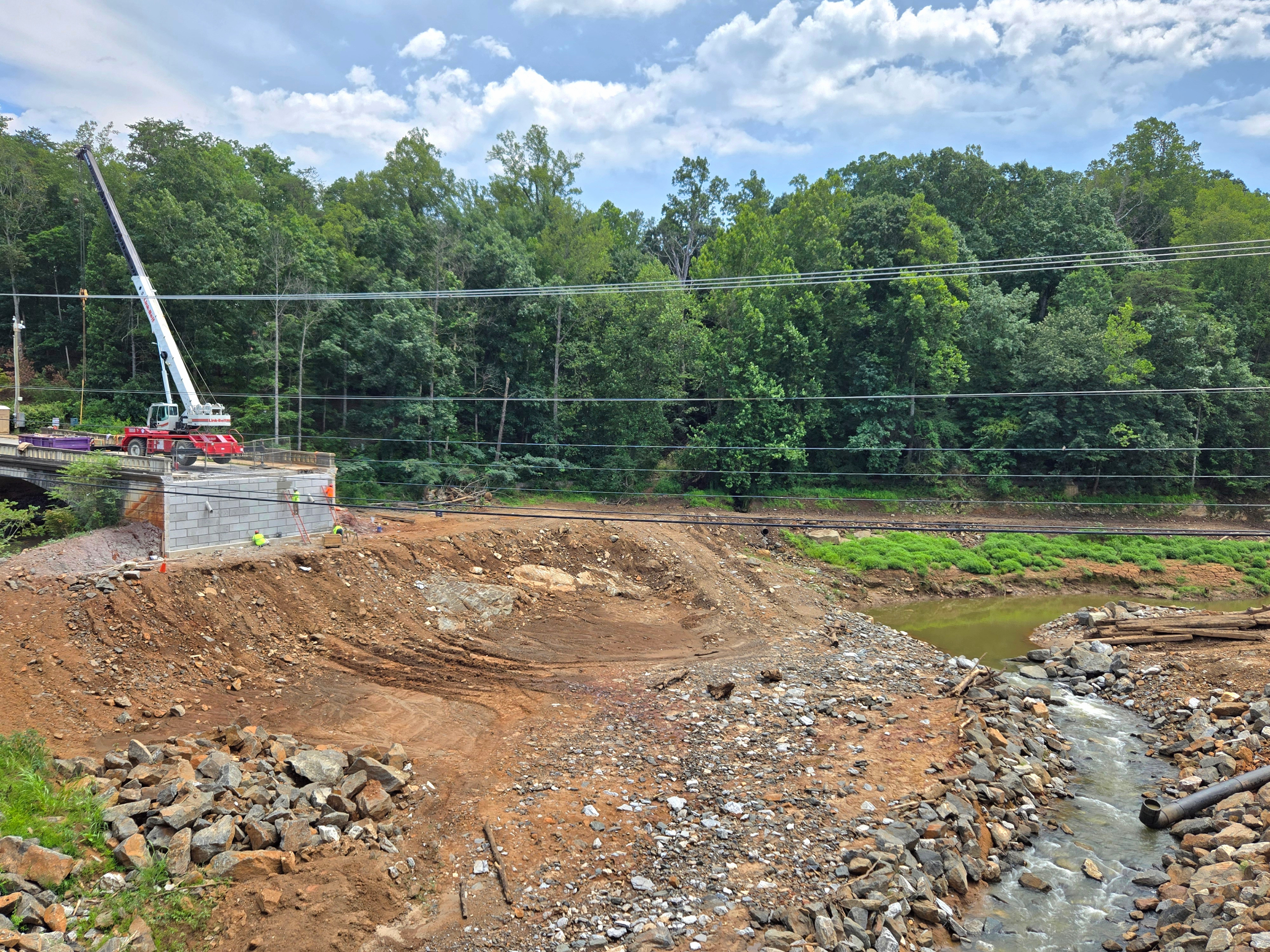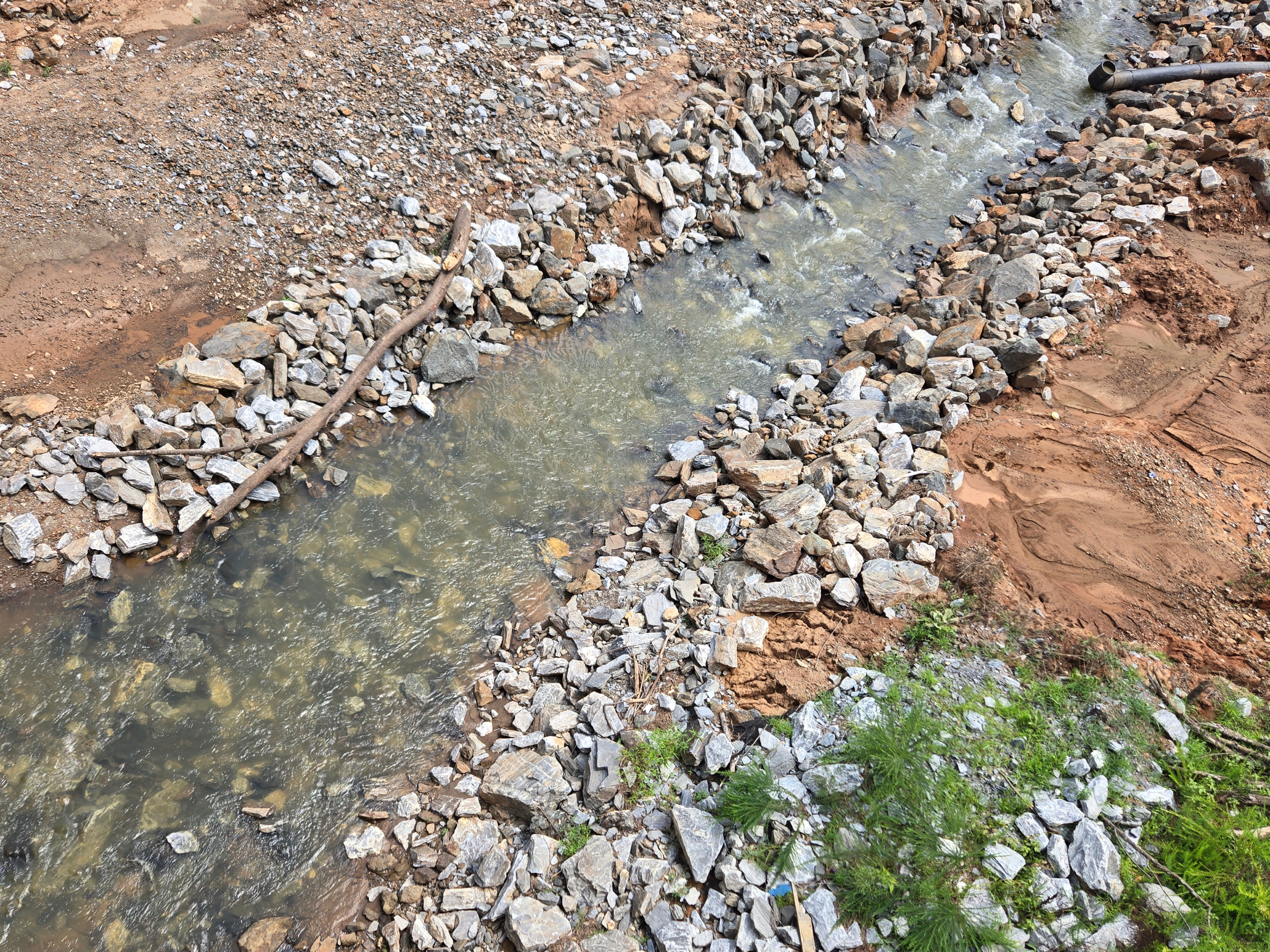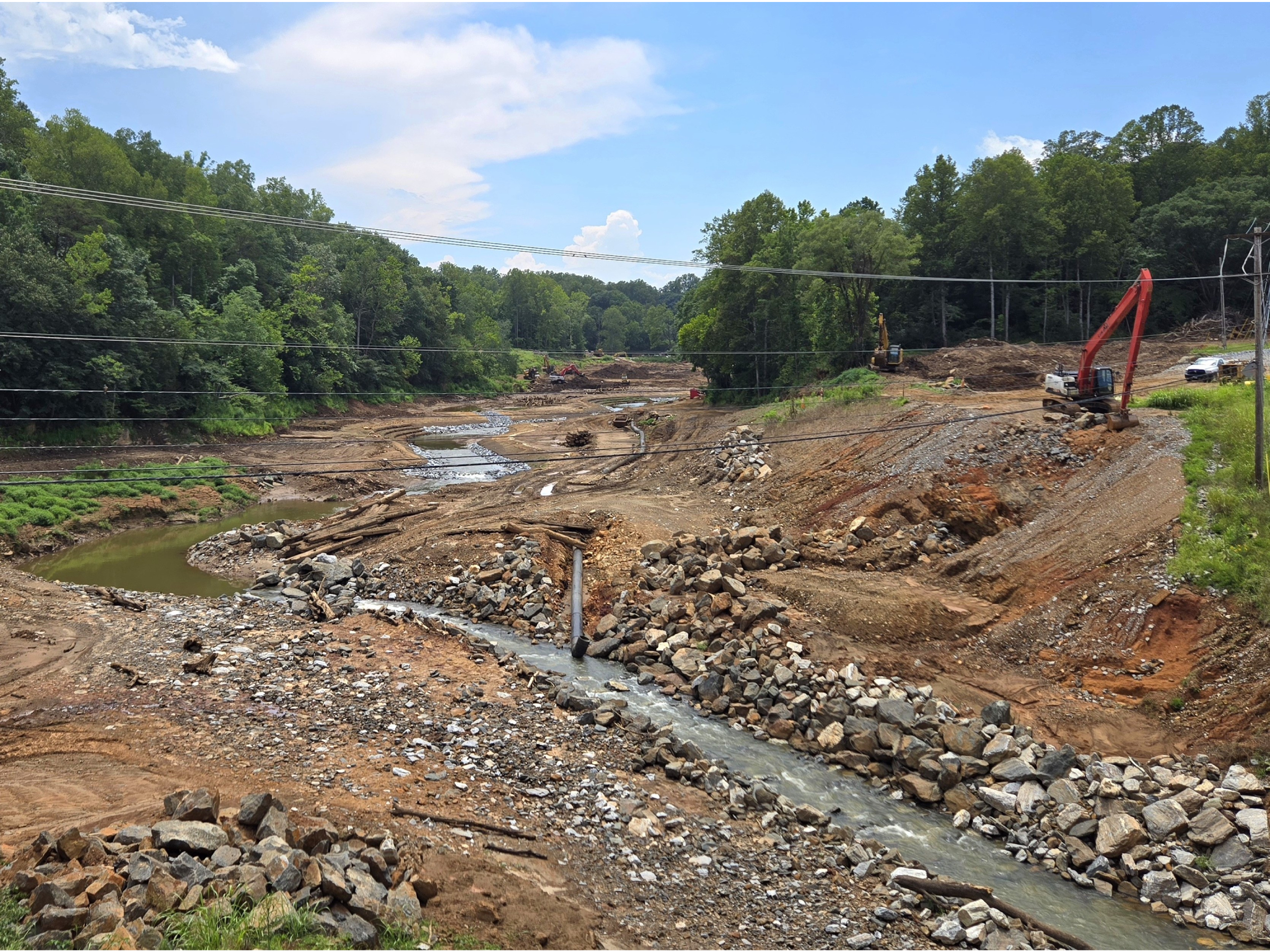Lynchburg’s largest tributary to the James River is in its final phase of restoration this summer, after the city has poured millions of dollars, thousands of hours of labor and hundreds of boulders and tree trunks into the local waterway.
Erin Hawkins, Lynchburg Water Resources’ project manager for the Blackwater Creek restoration, said one memory is keeping her motivated in the last stage of work. When she closes her eyes, she can picture the exact moment on May 23, 2024, when the upstream and downstream waters of Blackwater Creek converged.
It marked the first time in nearly a century that the waterway moved as nature intended, Hawkins said. College Lake Dam and College Lake itself, located on the University of Lynchburg’s campus next to Lakeside Drive, had blocked the creek’s natural path since the 1930s.
As Hawkins watched the water flow over what remained of the College Lake Dam that spring day, she said she realized that “this is a once-in-a-lifetime legacy to leave, to honor what this land once was.”
Lynchburg Water Resources staff and consulting engineers have been working to remove the dam and restore Blackwater Creek to its original condition ever since a flooding scare prompted city officials to deem the dam a public safety risk in 2018, Hawkins said.
Seven years and $22 million later, construction crews are nearing the end of the mile-long stretch of creek that they set out to stabilize. Hawkins said the project should be finished by late summer or early fall. 
What is restoration?
Hawkins said the piles of dirt, scraps of wood and lines of excavators and bulldozers in the floodplain today can be misleading — they look like elements of destruction, not restoration.
Instead, it’s helpful to think of restoration as a form of construction, messy like any other, Hawkins said. Her team is building a stable channel for the waters of Blackwater Creek to travel through, she said.
Stream restoration involves installing tree trunks, gravel and boulders in the stream bed to protect banks from erosion and create habitat for aquatic wildlife, according to the restoration project site. In the surrounding wetland habitat, restoration entails planting grasses and trees to create root systems that will stabilize the land.
That work is necessary to mitigate flooding concerns, Hawkins said. If construction crews were to just drain College Lake and let the water go where it wants to flow, it would move quickly in the path of least resistance and erode the land along the way, she said.
Building a stable creek bed with lots of curves for the water to twist and settle into, on the other hand, lets Blackwater Creek move in a slower and more controlled way, Hawkins said.
“It’s the difference between a fire hose and a garden hose,” Hawkins said, describing the impacts of stream restoration on water flow.
Restoring a wetland habitat where College Lake once sat is a crucial part of the project too, Hawkins said, as it creates an open space for water to drain if it ever does overflow the constructed creek channel.
“Wetlands, for this project, are not going to solve flooding problems, not going to make them magically go away,” Hawkins said. “But they will help so that water doesn’t get out of its banks and cause havoc.”
These restoration initiatives are the last steps after years of design, planning and construction, Hawkins said, which included the building of a new $27 million bridge on Lakeside Drive, officially called the Rosel and Elliot Schewel Memorial Bridge.
The long timeline was largely due to the challenges of completing the permit process with the Army Corps of Engineers and coordinating work between multiple agencies, Hawkins said. Lynchburg Water Resources partnered with WC English Construction, Resource Environmental Solutions and AECOM, an environmental engineering firm, to complete the project. Hawkins’ team also worked with the University of Lynchburg, which owns the portion of the creek that’s being restored and the land around it.
The project is funded in part by state awards, including a $5 million grant from the Department of Conservation and Recreation and a $10 million low-interest loan from the Virginia Clean Water Revolving Loan Fund, Hawkins said. 
Damned if you do and damned if you don’t
College Lake Dam was labeled as “high hazard” as far back as 2011, according to a report from the Virginia Department of Conservation and Recreation. The report defines “high hazard” as “in need of repairs to meet minimum safety standards based on hazard to life and property from a dam failure.”
The city didn’t seriously consider removing the dam until 2018, Hawkins said, when an August thunderstorm dropped at least 6 inches of rain on Blackwater Creek and its tributaries in the span of a few hours. Water flowed over the dam and onto what then was Lakeside Drive. The flooding event made national news when more than a hundred households needed to be evacuated.
City officials decided then that the dam needed to go, Hawkins said, especially with severe rain events becoming more common.
The area is heavily trafficked, making flash flooding all the more of a risk, Hawkins said: The bridge on Lakeside Drive averages about 17,000 vehicles a day.
“At the end of the day, we had a job to protect public safety,” Hawkins said.
But not every expert agrees that removing the dam is beneficial for the community. Thomas Shahady, professor of environmental science at the University of Lynchburg, said the dam was integral to preserving local water quality, and he’s concerned about pollution levels now that the dam is gone.
When the earthen dam was first constructed in the 1930s, it created a clean lake perfect for recreation, said Shahady, who has studied College Lake and Blackwater Creek since 2005. Residents swam in the summer, canoed in the fall, ice skated in the winter and fished in the spring.
Starting in the 1950s, pollution took its toll on the water system, Shahady said. The post-World-War-II population boom led to an increase in high-density housing in Lynchburg, which sent everything from sewage overflow to construction site runoff to College Lake.
Despite the increase in pollution, Blackwater Creek remained protected when the dam was in place, Shahady said. It trapped sediment and pollution in College Lake, keeping the creek itself clean.
Blackwater Creek eventually flows into the James River, which is one of two drinking water sources for Lynchburg, along with the Pedlar Reservoir in Amherst County, according to Lynchburg Water Resources’ 2024 water quality report. While the dam once kept pollutants out of that water source, everything will now flow freely, Shahady said.
Pollution is also a concern outside of Lynchburg’s borders, he added.
The James River eventually feeds into the Chesapeake Bay, which is harmed by pollution collected upstream. The Chesapeake Bay Foundation cites nitrogen, phosphorus and sediment as the “three major contributors to the poor health” of the water system.
All three pollutants will move through Blackwater Creek now, Hawkins said, because they are a part of Lynchburg’s everyday environment. Nitrogen and phosphorus enter water systems through runoff from farms and cities alike, coming from nutrient-dense substances such as fertilizers and wastewater. Sediment comes from the natural process of erosion and not-so-natural disturbances such as construction and high-density development.
Hawkins added that her team is stabilizing and reinforcing the creek and surrounding wetland, which will help to absorb and filter some of the nutrient pollution and minimize sediment runoff.
Shahady is skeptical. He said any stabilization attempts made now can’t undo Lynchburg’s centuries of urban development and resulting environmental degradation.
“The argument is, ‘Let’s restore it to its former, natural condition.’ But that’s just not possible because it’s been so degraded already,” he said. “If you don’t completely un-urbanize, [the creek] is just going to keep returning to a scoured and destroyed state.”
Flooding is one unavoidable consequence of that urban environment, Shahady said, whether it comes in the form of a failing dam or an overflowing creek.
Hawkins said the threat of the old dam failing and the future likelihood of evacuations like the one in 2018 were too big a public safety risk to ever justify preserving College Lake.
“I’ve remained focused on getting this project to the end goal,” she said, “removing the threat of an over-topping of a dam.”
Lynchburg isn’t alone in wrestling with the pros and cons of removing old dams, Shahady said. There are only two natural lakes in Virginia — Lake Drummond and Mountain Lake — and the rest have been created by manipulating the environment. Shahady plans to publish a book in 2026 to help communities evaluate the effects of manmade lakes and dams on the environment, using College Lake as a case study. He’s calling it “Damming Consequences.” 
Looking downstream
Hawkins said she’s already seeing positive effects of the restoration.
Wildlife is abundant around the free-flowing creek, she said: Snapping turtles are making the creek’s shallow pools their new home, killdeer are building nests in the floodplain and herons are stopping by to snack on fish. Geese, deer, tadpoles and bald eagles have also been spotted this spring and summer as construction has moved farther downstream.
Restored areas of the creek have held up against summer rain, even the storms that hit Lynchburg in the week of July 13, Hawkins said.
Natural vegetation is taking root too, she said. Her team plans to help speed up that process by broadcasting thousands of seeds of native grasses, shrubs and trees as construction wraps up.
The work won’t stop after construction crews leave, Hawkins said. Water Resources will check in on the land throughout a five-year monitoring period to ensure the restoration efforts are working as they should. But the University of Lynchburg, which owns the creek and surrounding floodplain, will be the official steward responsible for long-term upkeep, she said.
Creekside Trail — a 5-mile path that’s part of the Blackwater Creek Trail network and the 300 acres of protected forest called the Blackwater Creek Natural Area — will reopen when construction crews leave, after being closed since January 2024.
Hawkins said there are plans to bring other recreational opportunities to the area too, including transforming part of the old bridge into an overlook and building additional trails and boardwalks.
In the meantime, Hawkins said, all she can do is patiently wait for nature to reclaim what once was College Lake. She said she plans to come back to the overlook at the same time every year to take a picture of the wetland and document every milestone of the area coming back to life.
“It will get back to that ‘once upon a time’ state, as a forested stream valley, and that will be really cool,” she said.
_______________________
Correction 10:55 a.m. July 23: The new bridge on Lakeside Drive is officially called the Rosel and Elliot Schewel Memorial Bridge. The name was incorrect in an earlier version of this story.



